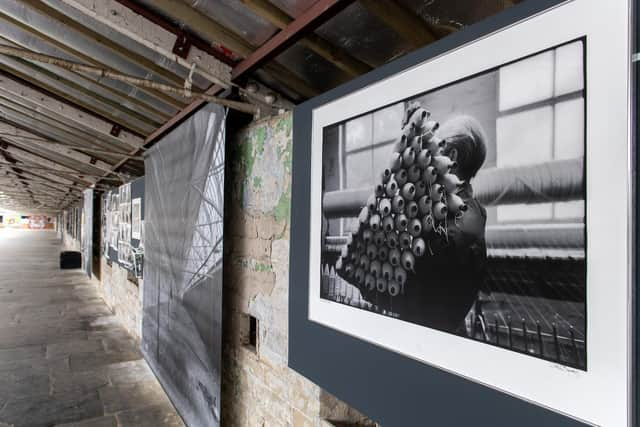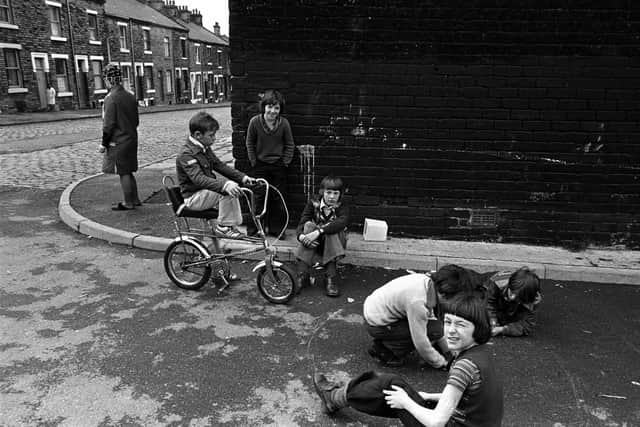Four decades of photographs of Yorkshire grit by Ian Beesley go on display for the first time
With an archive of 60,000 images to choose from, Beesley admits it has been quite a task selecting what to include in Life: Ian Beesley Retrospective.
“I have found it quite difficult – you can get lost going down wormholes,” he says. “But it is great here because you have the space to lay things out and try and work it out.”
Advertisement
Hide AdAdvertisement
Hide AdThe gallery is more than 190m long, around the length of two football pitches, and is a fitting setting for Beesley’s work, not only because with a lifetime’s imagery to display there is plenty of room for it to breathe, but also because of the subject matter of many of the photographs. They chronicle the deindustrialisation – and consequent loss of many skills and trades – that has taken place since Beesley first began taking pictures in the 1970s. He also has a long personal association with Salts Mill.


“It is one of the most amazing buildings in the world and I have photographed it when it was still a working mill, when it was derelict and when Jonathan Silver took it over,” he says. “I was approached by other galleries and institutions to do a retrospective but I couldn’t think of a better place to exhibit my work.”
Beesley’s early interest in photography came from his father. “He was a keen amateur photographer – he used to print his pictures in the kitchen and I was always fascinated by that.”
After leaving school Beesley first worked in a mill (“I hated it”), then at a foundry and eventually got a job at Bradford Council’s Esholt sewage works. He credits his colleagues there with giving him the confidence to follow his passion for photography.
Advertisement
Hide AdAdvertisement
Hide Ad“They knew that the way out of that cycle of unskilled labour was education and they really encouraged me. It was while I was working there that I got my first camera – and I took pictures of my co-workers, they were real characters.”


He applied to Bradford Art College and then went to study at Bournemouth & Poole College of Art. On his graduation in 1977 he was awarded the Kodak scholarship for social documentation and that was the start of an accomplished career documenting the cultural and industrial heritage of the North, and its people.
Almost every image on display in the exhibition features people, often at work, sometimes at play – they are at the heart of Beesley’s work and the care and respect he extends to them is evident in every single frame.
“I like to think they are honest photographs,” he says. “I take pictures of ordinary people going about their lives. When I started in the 1970s, I looked at photographs of Bradford and of industry and they were either very patronising or cynical – it didn’t reflect my experience and I thought we deserved something better.” He says that the American documentary photographer Paul Strand (1890-1976) has been an inspiration. “He said that ‘everything you ever need to photograph you will find within a mile of your doorstep’. He was a humanist photographer and that is what I aspire to.”
Advertisement
Hide AdAdvertisement
Hide AdBeesley’s route into photography came through an initial interest, a natural curiosity about people and then training and education. “The sad thing is that what I have been able to achieve, I wouldn’t be able to achieve if I was starting out now. The arts have become dominated by affluence. In the 1960s and 70s there were photographers like David Bailey and Terence Donovan, who were working class, coming up through an education system that supported them. Now photography – and all the arts really – is full of privately educated, independently wealthy people who can afford to do unpaid internships. All this talk of levelling up, it’s not happening.”


Most of Beesley’s work is in black and white, originally because he couldn’t afford colour film. “You used to be able to buy ex-RAF film and I did that because it was cheap and then when digital came in, I thought I should move over to colour.” He first tried it out when he was doing a project at Kirkstall Forge and he received an interesting response from one of the workers he photographed who was disappointed when he saw all the colour pictures Beesley had put up in the canteen for the staff to look at. “He said to me – ‘where are all the black and white pictures? Those black and white pictures – they look how it feels to work in industry.’ And he was right, I was wrong; I took that as a really good point.”
Over the years, Beesley has worked on photographic projects in a variety of workplaces as well as, more recently, on medical research projects – he has been the photographer in residence for Born in Bradford, the long-term health study, for the past 15 years and has worked extensively with dementia patients. “The work I do is a collaboration,” he says. “I like projects where I can spend a considerable amount of time with people. Most of the foundries and factories I’ve worked with has usually been a year or 18 months.”
His approach is to “have a chat and take the odd picture”. He is interested in observing people and getting to know them. “I always carry a notebook with me, in fact my notebooks are as important, if not more important than the camera.” One of his longest-running projects was with Hayroyd’s Colliery, a drift mine in West Clayton between Huddersfield and Barnsley. “I went there on and off for around 20 years,” he says. “We got on really well.” He went underground with the miners and says that he often ended up doing a bit of labouring. “I thought that was fair trade – they were giving me something, so I was happy to do something for them.”
Advertisement
Hide AdAdvertisement
Hide AdThe exhibition very movingly pays tribute to all the people and places Beesley has seen and photographed over the past four decades – it is quite a legacy. He admits it has been a sometimes-emotional experience revisiting his work for the show. “Especially now it’s all up, just looking around at it all. I think well… I’ve had a go, haven’t I?”
Life: Ian Beesley Retrospective is at Salts Mill, Saltaire until October 30. The gallery is open 11am-4pm, Wednesday to Sunday. www.saltsmill.org.uk/